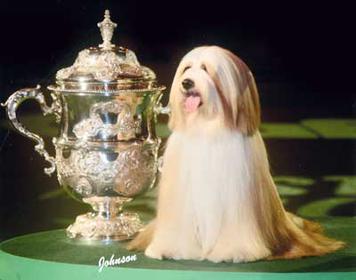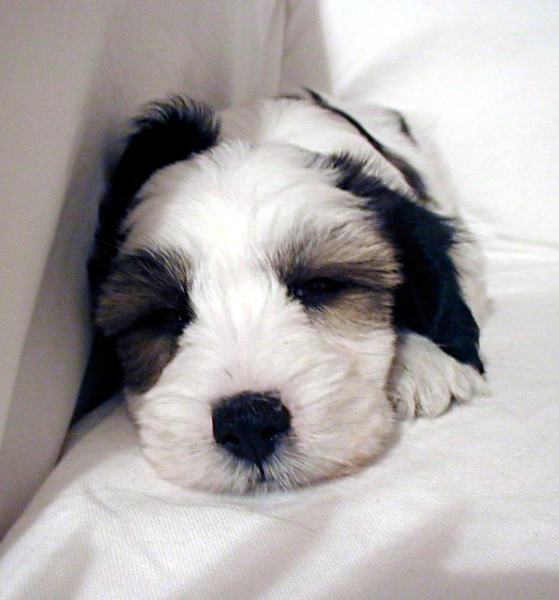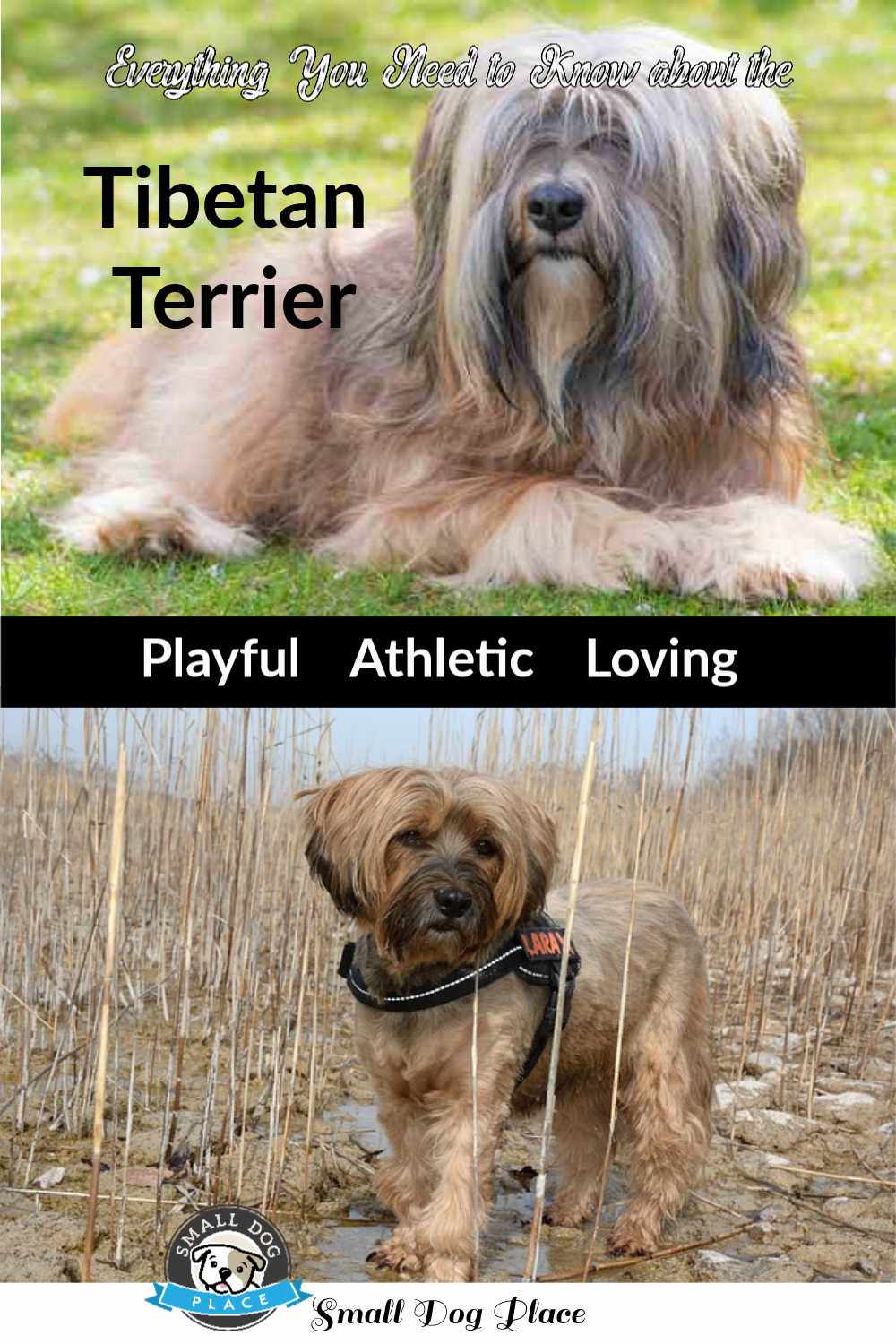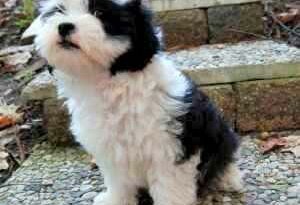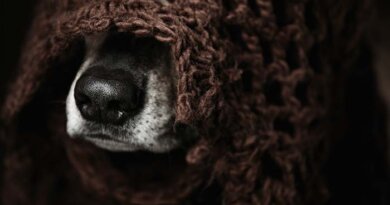Tibetan Terriers Complete Dog Breed Profile and Information
Looking for the quintessential shaggy dog? You might find it in this breed. Although the beautiful Tibetan Terrier shown below is anything but shaggy, most non-show dogs enjoy life to the fullest without worrying much about their hair-do. After all, that’s a human problem, now isn’t it?
Another thing we should get clear from the onset is that these dogs are terriers in name only. They are not true terriers, nor do they show any typical terrier traits. They are not hyper, have little prey drive and more easy-going than any representative of the terrier group.
Tibetan terriers evolved from being a holy dog, a good
luck charm, and a protector of monasteries to a lovable companion, good with
families, children, singles, and couples.
Based on recent DNA studies, the TT as they are often called is one of
the ancient breeds domesticated from old Spitz like wolves of central Asia.
According to Jane Reif, author of “The Tibetan Terrier Book,” the breed evolved
from a wolf-like prototype dog with long legs.
These prototype dogs wandered the area west of the Gobi Desert and
farther north to what we now know as Tibet.
But, much of the breed’s history has been passed into legend.
Standing on average of 14 to 16 inches at the shoulder and
weighing 20-24 pounds, this breed although larger than most small dogs on this
site still follows our guidelines for “small breed dog.”
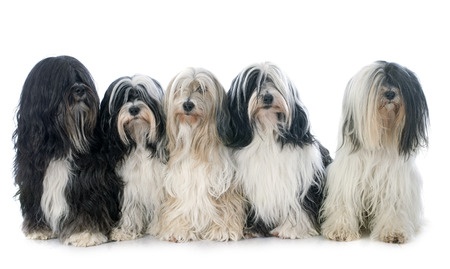
Perhaps the most dramatic characteristic of
the breed is their long, thick, double coat that covers their face and
eyes. This trait no doubt passed down
from ancient times when the breed lived in frigid, harsh mountainous
terrain. It has the texture of human
hair and can be straight or wavy but not curly.
Their eyes may be hard to see
with their hair falling over them, but they are dark and the TT sees just fine
due to their long eyelashes that keep the hair out of their eyes.
They are affectionate, smart, and adaptable to many types of
families and make excellent watch dogs.
They are great with children who have been taught to respect them and
are generally fine with other pets.
They
make great pets for apartment dwellers, homes in the country and everything in
between. Playful, and comical at times,
these dogs bond very closely to their humans which sometimes makes them
susceptible to separation anxiety.
They learn fast with positive training
techniques, but they do have an independent spirit so consistency works
best. While some enjoy cuddling, they
are not always your typical couch potato canine.
Quick Facts About the Tibetan Terrier
Quick Facts
Other Names Used: TT,
Tsang Apso, Dokhi Apso
Affiliation: AKC
& CKC: Non-Sporting, KC: Utility, UKC:
Companion
Coat Type: Thick
double coat with a soft, thick undercoat. The outer coat is straight or wavy and fine textured but not silky. The outer coat continues to grow but should be trimmed if needed
so it does not fall to the ground. A real shaggy dog appearance
Colors: Wide range of
colors including Black, Brindle, Gold, Sable, White, Brown, Red, Fawn, Gray,
Silver and combinations of these colors. Dogs participating in Conformation
events must have black noses. Brown
Tibetan Terriers will have a brown nose. Some colors may change overtime.
Activity Level:
Moderate to High
Good with Children:
Yes
Good with other pets:
Yes, but some can be jealous of other dogs living in the same household
Average Puppy Cost: $1000-1500
Litter Size: Average 6
| Traits | Rating |
|---|---|
| Playfulness | |
| Affection Level | |
| Friendliness Towards Strangers | |
| Good with Children | |
| Good with Other Dogs | |
| Good for First Time Owners | |
| Exercise Needed | |
| Ease of Training | |
| Watch Dog Ability | |
| Grooming Requirements | |
| Shedding | |
| Cold Tolerant | |
| Heat Tolerant |
Explanations for At a Glance Ratings
- Playfulness: Most=5 Less=1
- Affection: Most=5 Least=1
- Friendliness Towards Strangers: Most=5 Least=1
- Good with Children: Good=5 Not Good=1
- Good with Other Dogs: Good=5 Not Good=1
- Good for First Time Owners: Good=5 Not Good=1
- Amount of Exercise Required: Much=5 Minimal=1
- Ease of Training: Easy=5 Difficult=1
- Watch Dog Ability: Excellent=5 Poor=1
- Grooming Needs: Extensive=5 Minimal=1
- Shedding: Heavy Shedding=5 Minimal Shedding=1
- Cold Tolerance: Cold Well Tolerated=5 Poorly Tolerated=1
- Heat Tolerance: Heat Well Tolerated=5 Poorly Tolerated=1
History of Tibetan Terriers
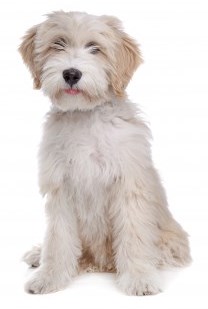 Fawn and White Tibetan Terrier
Fawn and White Tibetan TerrierMuch of the breed’s history is shrouded in legend; it is
generally accepted that they were raised and lived with lamas high in the
Himalayan Mountains. The monks called
them The Holy Dogs of Tibet, and their role in the monasteries was that of a
companion, watchdog, and sometimes herder.
There is also evidence that Tibetan Terriers were used to retrieve items
that had fallen down rocky slopes. Their
“snowshoe” feet gave them superb dexterity and sure-footedness, able to
maneuver in the snow.
They were
considered good luck and given as gifts to visitors to bring them luck. Selling these dogs might bring bad luck, so
the practice was never done.
Due to their isolation, these dogs remained purebred for
some 2000 years. It is likely they were
used in the formation of other breeds such as the Lhasa Apso, Tibetan Spaniel,
Shih Tzu, and others.
In 1922, a British surgeon, Dr. Agness Greig performed an
operation on a Tibetan woman and was given a puppy in appreciation. This gold
and white girl eventually became part of the foundation stock for the
breed that was formed in the west.
The doctor started a breeding program and then
in 1927, presented three generations of the Tibetan Terriers at a dog show in
Delhi.
From there, the Kennel Club of
India developed a breed standard and by 1930, the Kennel Club in England began
to register dogs under the name of Tibetan Terrier.
The first Tibetan Terrier dogs were imported to the U.S. in
1956 and then a year later the Tibetan Terrier Club of American was
formed. The AKC recognized the breed in
1973 placing it in the Non-Sporting Group.
Today, they ranked 88th in popularity in 2013 according to the AKC.
Even though their name implies that they in the terrier
group, they are not terriers at all. The
reason the terrier name stuck was that they resembled the same size as most
terriers classified in England at the time.
The English name was maintained even when they were introduced into
America.
Personality of Tibetan Terriers
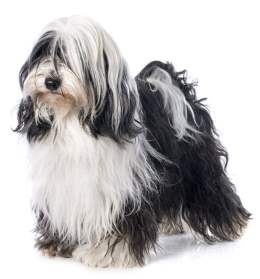 Black and White Tibetan Terrier
Black and White Tibetan TerrierPlayful, athletic, remarkably strong, and very agile, these
dogs make excellent companions and great family dogs.
Each dog is unique, so
making generalizations about any breed is difficult. Their personality is a result of their
genetic makeup and their environment from the day they are born and every day
thereafter.
Usually out-going, they can a little reserved at first
around strangers, but this trait makes them excellent watch dogs. They bond
closely with their owners, sometimes with only one member of the family.
People who have lived with this breed
maintain that the dog can even read their emotions. (This might be true of all dogs).
TT’s are excellent at adapting to the lifestyle of their
humans and can be content to lead a sedentary lifestyle or pick up the pace if
they live with active families.
They do
have an independent streak, so don’t be surprised if your TT wants to nap close
to your side one moment. Deciding the next,
it’s time to move onto more exciting activities whether or not they involve
you.
They are intelligent but do best with consistent, positive
training methods. The down side of their
high intelligence is that they learn very quickly how to get what they want
from humans, in essence training their owners.
This stubbornness comes out
during training, so patience is a must for owning or being owned by a Tibetan
Terrier. They participate and do well in agility, obedience, rally, flyball,
tracking, and even herding. They also
make excellent therapy dogs.
Grooming the Tibetan Terrier
This breed is not for anyone who hates to groom. Their long double coats require much brushing
to prevent mats from forming. While it has been said that many show dogs are
overly groomed according to the breed standard, the soft woolly undercoat will
mat easily without attention.
Since these dogs continue to grow their hair out, they are more hypoallergenic than other breeds.
Tibetans have an unusual hair growth cycle. They don’t shed, but loose hair similar to
humans. As a result, most pet owners
trim or have their dog professionally groomed in a puppy cut. The exception to this is a puppy.
When the puppy becomes an adolescent, his
hair will change to his adult coat.
During this time, mats regularly form as the full double coat of an
adult grows. Daily brushing may be
necessary. This is why it is important
to train a puppy early for grooming, even though they may not need it as often
as an adult would require.
Using a spray
conditioner prior to brushing is always advisable to prevent hair breakage and
to help remove small mats.
Bathing should regularly be done with a good canine shampoo
followed by a cream rinse or conditioner.
Tibetans prefer warm water, not too hot and not too cold. Most owners blow their dog’s coat dry with a
hair dryer.
Toenails will need to be trimmed, teeth brushed, and anal
glands checked periodically. The hair
between the foot pads grows continually as does the rest of the coat. Trimming the hair is advisable because hair
will mat in this area, causing pain to the dog.
Health Concerns of Tibetan Terriers
Tibetan Terrier Puppy Courtesy of Creative Commons
Tibetan Terriers are a strong and healthy breed of living 15
to 16 years. There are, however,
instances of diseases that pop up from time to time, many of them genetic in
nature.Some of the more common problems
of the breed include:Other problems include:
- Hypothyroidism
- Cataracts
- Canine neuronal ceroid lipofuscinosis. This disease, also known as Batten Disease in
humans causes night blindness, epilepsy, dementia and unexpected aggression. Scientists have uncovered the gene
responsible and now there is a DNA test that breeders can use.Feeding and Diet
Some Tibetan Terriers have food allergies to dairy, wheat, and grains. A grain free diet is often recommended if it is determined that wheat causes problems. Puppies should be fed three times a day until they are six months old and then twice a day throughout their life time.
A high quality dog food designed for small breed dogs is a good choice and it can be canned, kibble, raw or fresh. Some people opt for a home-made diet, but if this is your choice, fist consult your vet. It is difficult to get the nutritional needs just right when cooking for your dog. Use tiny treats when training that are of high quality such as tiny bits of chicken or turkey. Fruits and vegetables also make excellent treats for dogs and do not add too many calories.
Expect to feed about two cups per day of food divided by 2 meals.
Lifestyle
Best Suited For…
This is an excellent dog for singles, couples and families with older children. Smaller children will need to be taught how to properly and respectfully interact with a dog.
They do require daily exercise, so the ideal person will have enough time in their schedule for daily walks and playtime. They also do not like being left alone for long periods of time.
This means that people who work long hours may need to enlist the help of a friend or neighbor to visit at noon for a short playtime or walk. Doggie Daycare is another option if no one is home all day long.
They normally do fine with other dogs and pets in the household, although some have been known to show some jealous streaks.
Activity Level and Exercise Needs
Tibetan Terriers have bursts of energy where they love to run or play, but in between, they are more likely to want to snuggle near their favorite human.
They are not a breed with high endurance towards lengthy exercise routines and wouldn’t make the best running mate for humans inspiring to win a marathon.
Two or three short 20 minute walks would be perfect for this breed, or substitute a strenuous play session for one of those walks.
Training a Tibetan Terrier
This breed is intelligent and will respond to training easily especially basic commands, however, intelligent breeds have been known to outsmart their owners. You will want to assure that you have the upper hand so your dog won’t try to train you.
A positive approach to training is always far super to outdated negative training methods and not only work better but also help create a strong, lasting bond. Training treats work very well with this breed, but attention, praise, and lots of cuddles are also equally effective.
Consistency is the key, especially when it comes to house training. Create a schedule and stick with it.
Pros and Cons of Living With this Breed
Pros
- Happy, playful breed
- Bonds closely; makes a devoted pet
- Suitable for children and families
- Intelligent; relatively easy to train
- Small enough to live comfortably in an apartment
- Good Watch Dog
Cons
- Maybe too active for some
- Requires frequent grooming
- Can suffer from separation anxiety if left alone for long
periods of time- Maybe jealous of other pets
Breed Club and Further Information
Tibetan Terrier Club of AmericaTibetan Terrier Pin
Does This Article Deserve Your Thumbs Up?
We always appreciate your support and encouragement. Your thumbs up means so much to us.
Free Monthly Newsletter
Sign Up for Our Free Newsletter and get our Free Gift to You.
my E-book, The Top 10 Mistakes People Make When Choosing a Dog (and how to avoid them)
If you enjoyed this page, I’d love it if you’d let me know. Just click the button below. Thank you.
Sharing is Caring

